Leonardo Sciascia
Villa Palagonia: The Enigmatic "Villa of Monsters" and Its Fascinating History
Bagheria is a town on the northern shores of Sicily, near Palermo. It is mainly known for its many villas, which served as havens for the Palermo aristocracy in the 18th and 19th centuries. The most famous is Villa Palagonia, a testament to the island's eccentric artistic and historical tapestry.
Also known as the "Villa of Monsters," this captivating estate boasts an array of whimsical sculptures that transform its grounds into an otherworldly experience. Designed in the 18th century, Villa Palagonia is not just an architectural marvel but a window into the creative spirit of its owner.
Join us on a journey to Villa Palagonia. This masterpiece blends the charm of Sicilian heritage with a captivating history. It invites visitors to experience its beauty and the mysteries that linger within.
 Villa Palagonia.
Villa Palagonia.Architectural Features of Villa Palagonia
Villa Palagonia is a stunning example of Baroque architecture. Designed by architect Tommaso Napoli in the early 18th century, it is characterized by its elaborate details and dramatic flair.
The villa's design reflects the opulence and grandeur typical of the aristocratic residences of that era. Its façade is adorned with intricate carvings and decorative elements that draw the eye and invite closer inspection.
The centerpiece of Villa Palagonia is undoubtedly its grand staircase, which serves as a focal point of the design. With its sweeping curves and ornate balustrades, this staircase provides a dramatic entrance to the villa's interior.
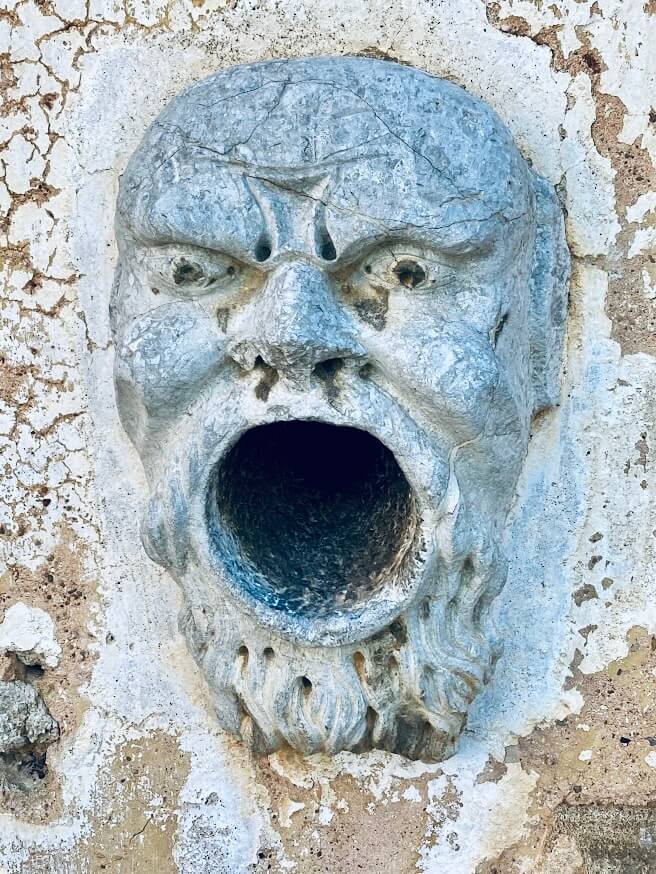 Detail from the top of the stairs.
Detail from the top of the stairs.Inside Villa Palagonia, visitors are greeted by a series of lavishly decorated rooms, each more impressive than the last. The villa's interiors feature frescoes, stuccoes, and gilded accents that reflect the wealth and status of its original occupants.
I visited the place a few years ago and got the impression that it had fallen into a bit of disrepair. But this in no way diminished its impact—to some extent, it may even have enhanced it.
The rooms are arranged in a symmetrical layout, each with its own theme. For example, there is the Room of Mirrors and the Room of Philosophers. The former's ceiling is decorated with mirror fragments, and the latter's walls are decorated with partly decayed pictures of the great thinkers of antiquity.
The History of Villa Palagonia
Villa Palagonia's history is at least as fascinating as its architectural features. It was built from 1715 on behalf of Don Ferdinando Gravina and Crujllas, 4th prince of Palagonia. The vision for the villa was influenced by the Baroque style, which was popular in Europe at that time. This style emphasized grandeur, movement, and dramatic contrasts, evident in the villa's design.
The villa's construction spanned several decades and involved numerous artisans and craftsmen. Each construction phase added new layers of complexity and detail to the villa's design. This collaborative effort resulted in a unique architectural masterpiece that stands as a testament to the artistic spirit of the 18th century.
Villa Palagonia has been a symbol of aristocratic privilege and artistic innovation throughout history. What makes it truly exceptional are the monsters created by the builder's grandson, Francesco Ferdinando II Gravina.
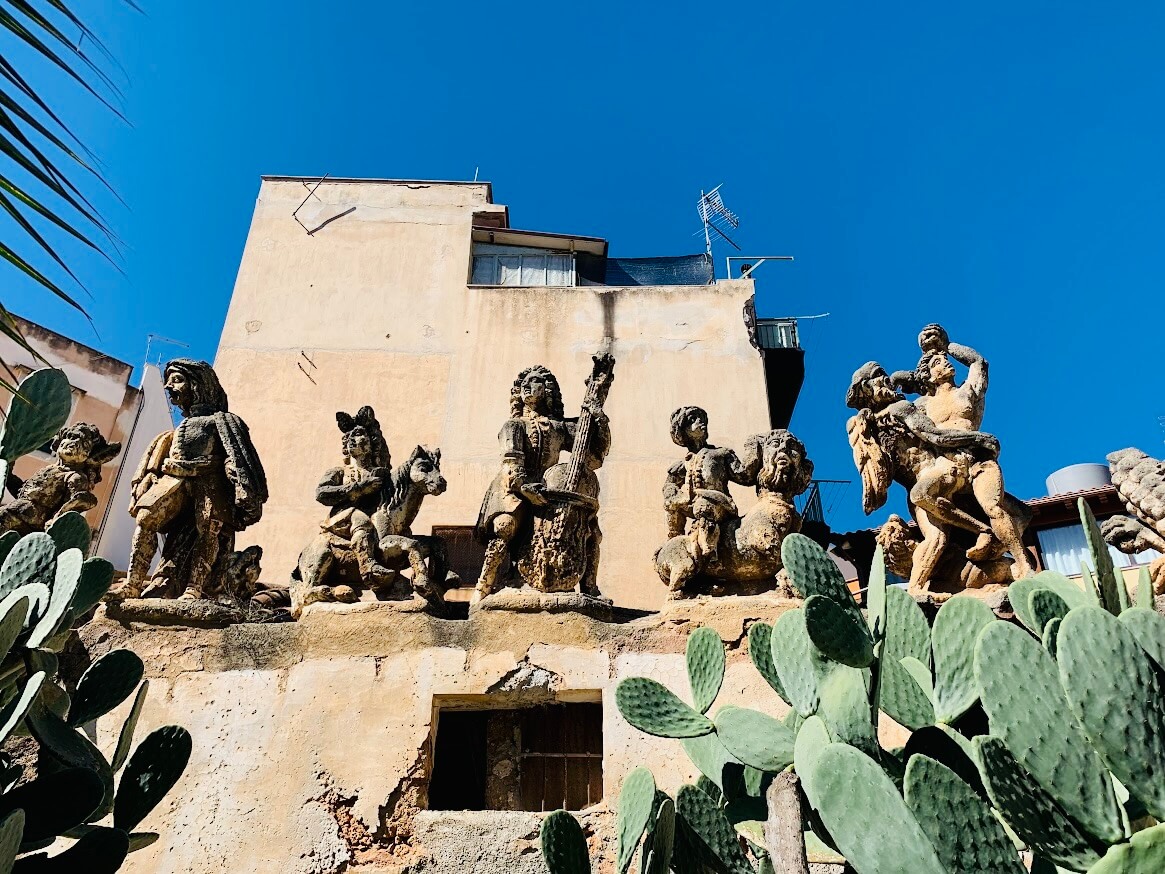 Many creatures inhabit the walls of Villa Palagonia.
Many creatures inhabit the walls of Villa Palagonia.The Enigmatic Sculptures and Their Meanings
Villa Palagonia's distinctive feature is its enigmatic sculptures, which adorn the gardens and exterior and earned the estate its nickname: the "Villa of Monsters."
The sculptures are a diverse array of fantastical creatures, grotesque figures, and whimsical characters. The origins and meanings of these sculptures have been the subject of much speculation and debate among the townspeople, historians, and art enthusiasts.
The sculptures were commissioned by Francesco Ferdinando II Gravina, 6th Prince of Palagonia, who was keen on the supernatural and the bizarre. Gravina's fascination with the unusual is reflected in the eclectic mix of figures that populate the villa's grounds.
Some sculptures represent mythological creatures. Others are caricatures of contemporary figures and allegorical representations of human virtues and vices. There is also a theory that they spring from the owners interest in alchemy.
And because we are in Sicily, it is no wonder that local speculation about the creatures' origins has also been linked to the owner's wife's lovers. Nothing thrills the Sicilian mind like the suspicion that someone has been made a cuckold.
The exact meanings of many of the sculptures remain a mystery, adding to Villa Palagonia's enigmatic allure.
Notable Events and Figures Associated with Villa Palagonia
Villa Palagonia rose to world fame after being described by the Scottish traveler Patrick Brydon in his best-selling book, A Tour through Sicily and Malta (1773). Brydon described the villa as an enchanted castle, noting, for example, the use of mirrors in one of the ceiling structures, which made even a few people look like a hundred-strong crowd.
The villa gained a reputation among European Grand Tour tourists thanks to Brydon. Johann Wolfgang Goethe and Alexandre Dumas visited the villa in this capacity. Goethe also described Villa Palagonia as part of his Italian Journey (1816), which raised awareness of the place even further.
Later, the villa attracted many noteworthy artists of the 20th century, such as surrealist André Breton, painter Renato Guttuso, and writer Jorge Luis Borges. An article in Life magazine in 1950 established the place's subsequent reputation as a cultural landmark.
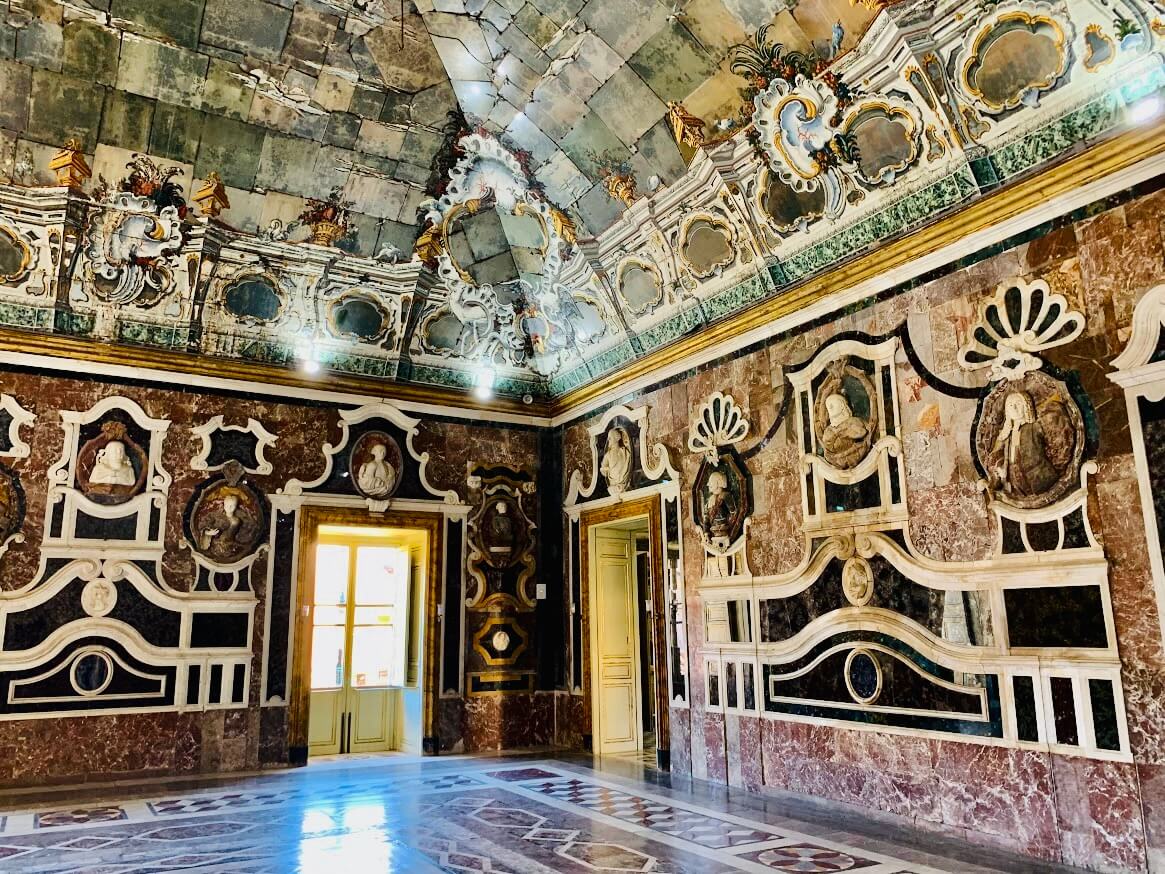 The mirrors in the ceiling of "The Room of Mirrors" ain't what they used to be.
The mirrors in the ceiling of "The Room of Mirrors" ain't what they used to be.Visiting Villa Palagonia: What You Need to Know
Villa Palagonia is located on the edge of Piazza Garibaldi, in Bagheria. The town is 15 km (about 9 miles) from Palermo. It can be easily reached by train. However, walking from the train station takes some time to get to Villa Palagonia.
We stopped in town on our way to Cefalu, which is another must-see attraction nearby.
Bagheria is a charming little town that may be particularly interesting to those interested in an authentic Sicilian atmosphere. There is little trace of its former glory. Many of the villas, once so beautiful, have fallen into disrepair, and the presence of the aristocracy is no longer a part of the town's atmosphere.
This doesn't mean the town isn't worth seeing. Some of the villas are still worth seeing, and there is also a long beach and many shops, cafes, and other activities.
You can find more info on Bagheria HERE.
Villa Palagonia is one of the town's most famous attractions. It is open for tours and visits. The official site has more information on opening hours and prices. The ticket office is right next to the villa.
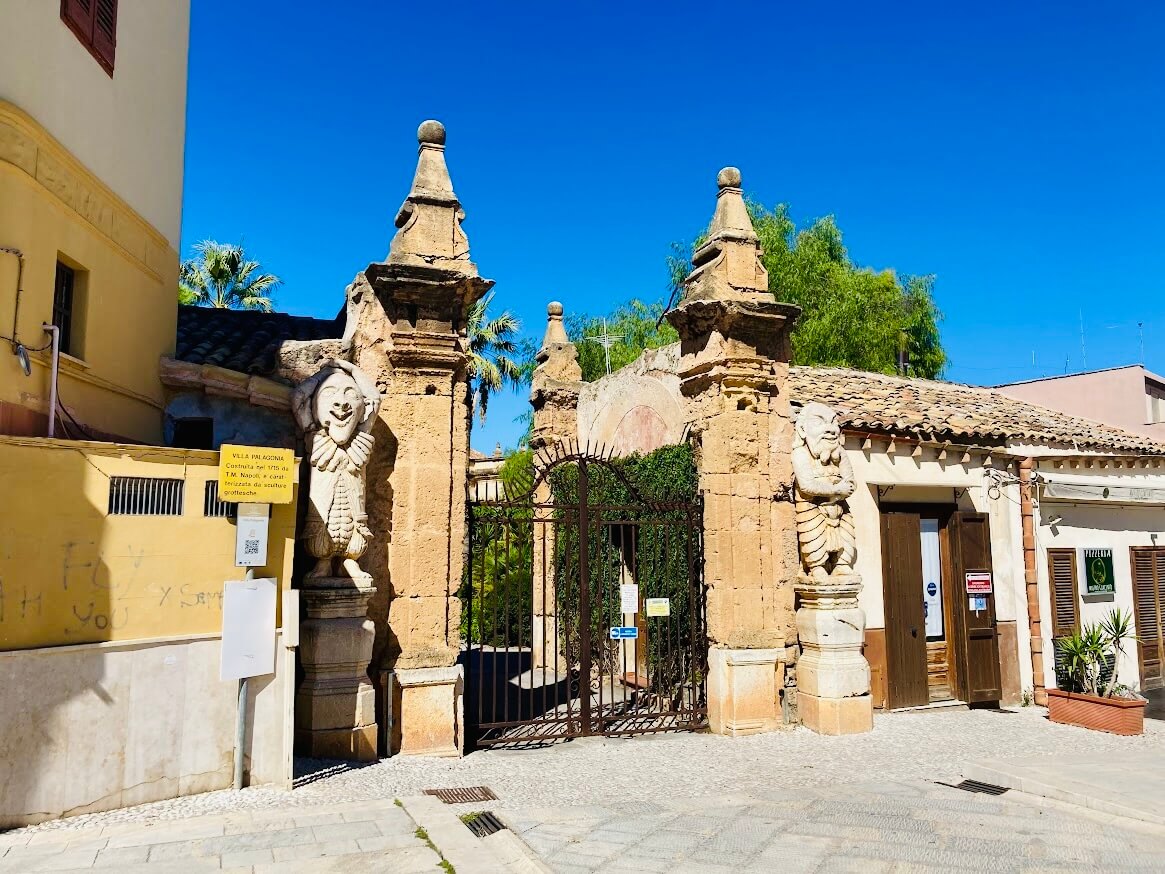 The front gate of Villa Palagonia. On the right is the ticket office.
The front gate of Villa Palagonia. On the right is the ticket office.Conclusion: The Enduring Legacy of Villa Palagonia
Villa Palagonia is more than just an architectural masterpiece; it symbolizes Sicily's rich artistic and cultural heritage. Its Baroque design and enigmatic sculptures reflect the creative spirit of the 18th century.
Villa Palagonia's enduring legacy is evident in its continued influence on art, literature, and culture. Its unique features and mysterious sculptures have inspired countless artists and intrigued visitors worldwide.
The villa's role in Sicilian culture and history ensures that it remains an important landmark and a source of pride for Bagheria's residents. The preservation efforts and cultural initiatives surrounding Villa Palagonia help safeguard its beauty and significance for future generations. You can also take part in these efforts for a small entrance fee.
Whether you are an art enthusiast, interested in architecture, a history buff, or simply someone who appreciates beauty and mystery, Villa Palagonia is a destination that promises to captivate and inspire. Still today, it serves as a testament to the power of art and culture to enrich our lives and connect us with the past.
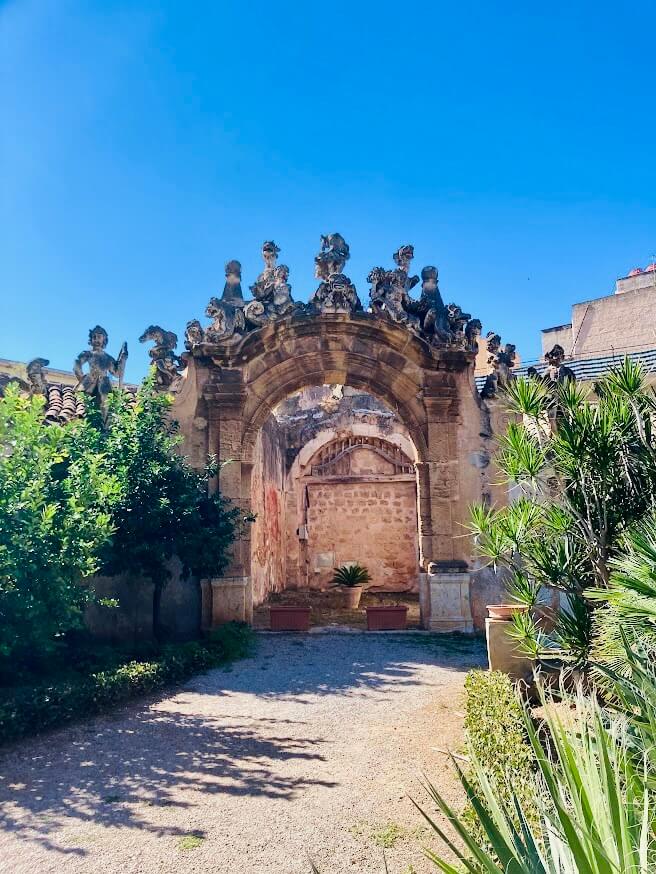
(May 7, 2025)
Recent Articles
-
Selinunte Park - History by the Sea
Nov 14, 25 05:02 AM
Selinunte park, its rise to glory, destruction, and how to visit it. -
Mount Etna Hiking: A Guide to Sicily's Sacred Volcano
Nov 05, 25 11:55 AM
Mount Etna hiking - Are you prepared to answer the mountain's call? -
Castles in Sicily: Memories Carved in Stone
Nov 03, 25 11:03 AM
Castles in Sicily: A look at the top of the crop
Follow MANY FACES OF SICILY on Facebook, Instagram, Bluesky & Tumblr
Contact: vesa@manyfacesofsicily.com







